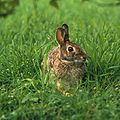- Apex predator
- By definition, healthy adult apex predators have no predators (with members of their own species a possible exception) and are at the highest numbered level of their food web.
In real-world ecosystems, there is more than one food chain for most organisms, since most organisms eat more than one kind of food or are eaten by more than one type of predator. A diagram that sets out the intricate network of intersecting and overlapping food chains for an ecosystem is called its food web.[6] Decomposers are often left off food webs, but if included, they mark the end of a food chain.[6] Thus food chains start with primary producers and end with decay and decomposers. Since decomposers recycle nutrients, leaving them so they can be reused by primary producers, they are sometimes regarded as occupying their own trophic level.[7][8]
The trophic level of a species may vary if it has a choice of diet. Virtually all plants and phytoplankton are purely phototrophic and are at exactly level 1.0. Many worms are at around 2.1; insects 2.2; jellyfish 3.0; birds 3.6.[9] A 2013 study estimates the average trophic level of human beings at 2.21, similar to pigs or anchovies.[10] This is only an average, and plainly both modern and ancient human eating habits are complex and vary greatly. For example, a traditional Inuit living on a diet consisting primarily of seals would have a trophic level of nearly 5.[11]




